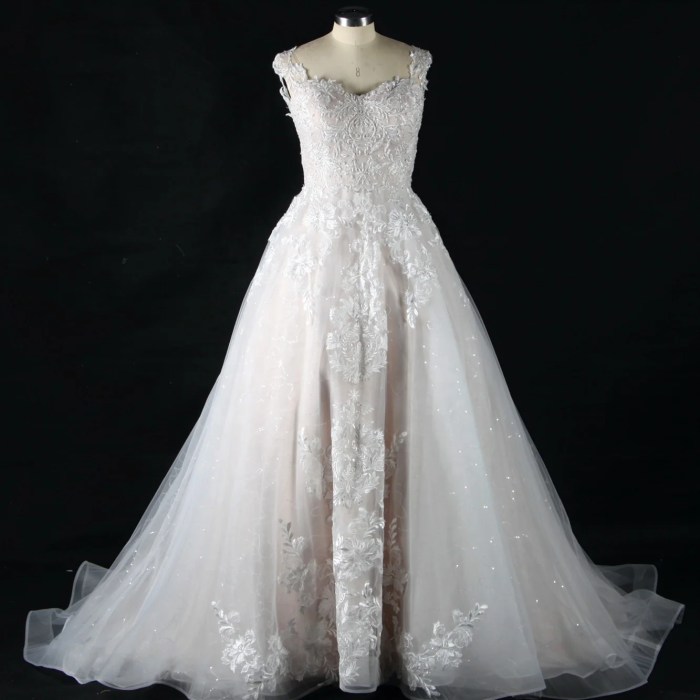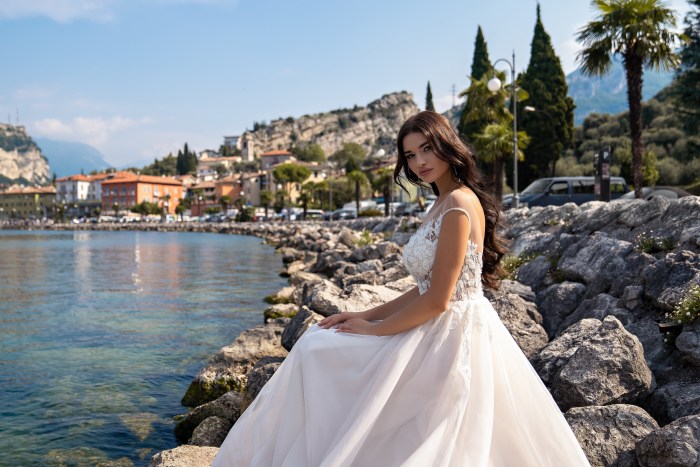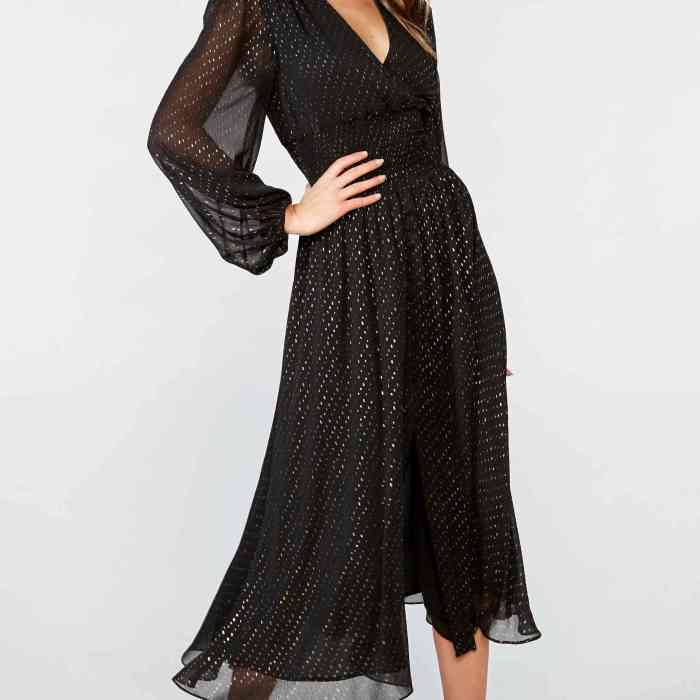Traditional Indian Wedding Attire: Indian Wedding Dress For Groom And Bride
Indian wedding dress for groom and bride – Indian wedding attire is a rich tapestry woven from centuries of tradition and cultural diversity. The garments worn by both bride and groom are not merely clothing; they are symbolic representations of heritage, status, and the union of two families. This section explores the evolution and regional variations of traditional attire.
Evolution of Traditional Groom’s Attire
The groom’s attire has evolved significantly across different regions of India. In the north, the sherwani, a long coat, has been a staple, its design evolving from simple, elegant silhouettes to richly embellished versions. The dhoti, a traditional lower garment, remains popular, often paired with a kurta (long shirt). In contrast, South Indian grooms might opt for a veshti (dhoti) and angavastram (a long piece of cloth draped over the shoulder), often in vibrant silk.
Western India sees a preference for achkan, a close-fitting coat, and churidar (tight-fitting trousers). These variations reflect the diverse cultural landscapes of India.
Significance of Colors and Fabrics in Bridal Attire
The colors and fabrics used in bridal attire hold deep cultural significance. Red, considered auspicious in many communities, symbolizes prosperity and good fortune. However, regional variations exist. Bengali brides often wear red and white, while South Indian brides may choose vibrant colors like yellow, green, or orange, depending on their community and family traditions. The choice of fabric, from silk to brocade to velvet, further adds to the richness and symbolism of the attire.
For example, Banarasi silk is highly valued for its intricate weaving and luxurious feel.
Regional Variations in Groom’s Turbans, Indian wedding dress for groom and bride
The groom’s turban, or safa, is a significant part of his attire, especially in North and Western India. The style, fabric, and color of the safa vary considerably across regions. Rajasthani safas are often elaborate, featuring intricate embroidery and embellishments, while Punjabi safas might be simpler, emphasizing the rich fabric and color. The safa is not just a head covering; it is a symbol of status and honor, reflecting the groom’s family and community.
Regional Variations in Bridal Jewelry
| Region | Necklace | Earrings | Head Jewelry |
|---|---|---|---|
| North India | Rani Haar, Choker | Jhumkas, Chandbalis | Maang Tikka, Nath |
| South India | Kasu Mala, Temple Jewelry | Vaddanam, Jimikki | Billa, Gajra |
| West India | Tanmaniya Haar, Layered Necklaces | Jhumkas, Balis | Borla, Veni |
| East India | Floral garlands, Gold necklaces | Traditional gold earrings | Floral headpieces, simple hair accessories |
Modern Interpretations of Indian Wedding Attire
Contemporary fashion has significantly influenced traditional Indian wedding attire, leading to a fascinating blend of heritage and modernity. While preserving the cultural essence, designers are incorporating contemporary elements to create unique and stylish ensembles.
Influence of Contemporary Fashion on Traditional Garments
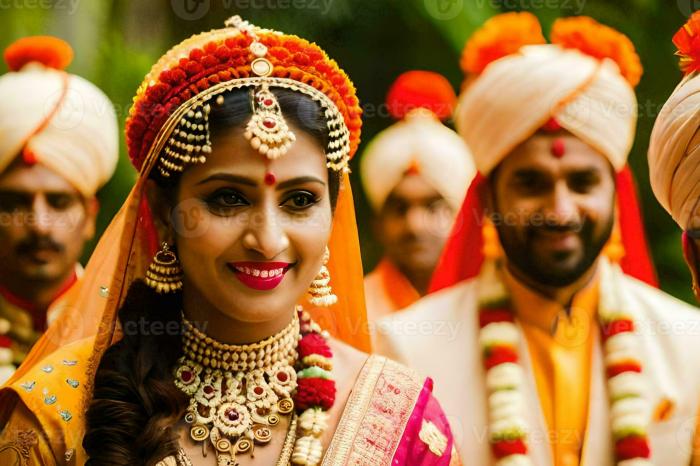
Source: vecteezy.com
Modern designers are experimenting with silhouettes, fabrics, and embellishments, resulting in fresh interpretations of classic styles. The sherwani, for example, is now seen in slimmer fits, with modern cuts and unexpected color combinations. Bridal lehengas are incorporating contemporary design elements, such as asymmetrical hemlines and unconventional necklines, while retaining the traditional embroidery and rich fabrics.
Incorporating Modern Elements While Preserving Cultural Heritage
The key lies in finding a balance. Designers achieve this by using traditional techniques on modern silhouettes or incorporating modern embellishments within the framework of traditional garments. For instance, a classic bridal lehenga might feature contemporary embroidery techniques alongside traditional motifs, creating a unique fusion of old and new.
Modern Takes on a Traditional Groom’s Sherwani
Here are three modern interpretations of a traditional groom’s sherwani:
- A slim-fit sherwani in midnight blue velvet, featuring subtle gold embroidery on the collar and cuffs. The fabric’s luxurious feel and the understated embellishments create a sophisticated and contemporary look.
- A sherwani in ivory silk, adorned with intricate geometric patterns using contemporary embroidery techniques. The use of a lighter color and modern geometric patterns offers a fresh take on the classic style.
- A sherwani in a bold jewel-toned color like emerald green, made from a lightweight brocade. This combination provides a modern and vibrant feel while maintaining the traditional elegance of the sherwani.
Adapting Traditional Embroidery Techniques for Modern Bridal Lehengas
Traditional embroidery techniques like zardozi, aari, and phulkari are being adapted for modern bridal lehengas by using them in new and innovative ways. For instance, zardozi embroidery, traditionally used for dense embellishment, is now used in more minimalist patterns, creating a contemporary feel. Aari embroidery, known for its delicate lines, is used to create intricate floral motifs on lighter fabrics, providing a modern contrast.
Fabrics and Embellishments
The choice of fabrics and embellishments significantly impacts the overall look and feel of Indian wedding attire. The selection reflects not only aesthetics but also cultural significance and regional preferences.
Popular Fabrics in Indian Wedding Attire
Silk, especially Banarasi silk, remains a popular choice for bridal lehengas and groom’s sherwanis. Its luxurious feel and intricate weaving make it a timeless favorite. Velvet adds richness and opulence, often used for winter weddings. Brocade, known for its intricate patterns, provides a more formal and traditional look. Lighter fabrics like georgette and chiffon are often used for summer weddings.
Embroidery Techniques in Indian Wedding Clothes
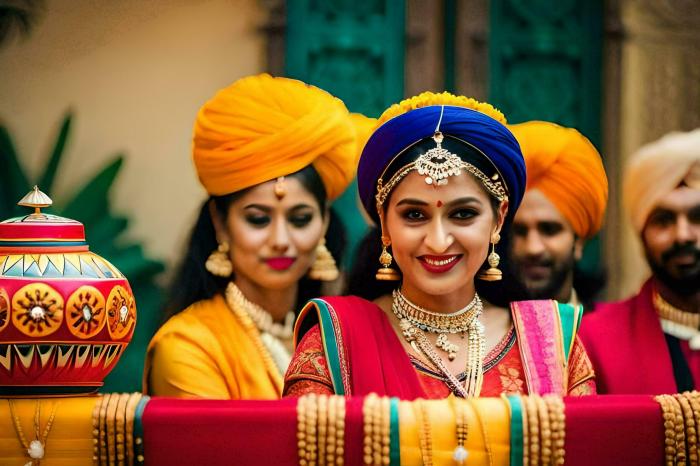
Source: vecteezy.com
Various embroidery techniques are used, each with its unique history and style. Zardozi, originating in Persia, involves intricate metal thread embroidery. Aari, a traditional hand embroidery technique, uses a hooked needle to create delicate designs. Phulkari, a Punjabi embroidery style, uses vibrant threads to create floral patterns. These techniques are often combined to create rich and layered embellishments.
Use of Gemstones and Other Embellishments
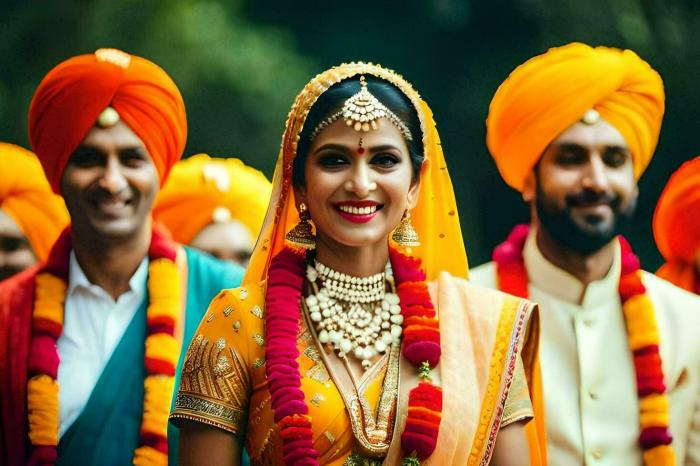
Source: vecteezy.com
Gemstones and other embellishments play a crucial role in enhancing the richness of Indian wedding attire. Precious stones like diamonds, emeralds, and rubies are frequently used, often symbolizing wealth and prosperity. Pearls add a touch of elegance and sophistication. Other embellishments include sequins, beads, and metallic threads, all adding to the overall visual impact.
Types of Embellishments
- Metallic Threads: Zardozi, zari, gota patti
- Gemstones: Diamonds, emeralds, rubies, pearls
- Beads: Glass beads, pearl beads, kundan beads
- Sequins: Various sizes and colors
- Other embellishments: Mirror work, patch work
Accessories and Jewelry
Accessories and jewelry are integral parts of Indian wedding attire, adding layers of meaning and enhancing the overall aesthetic appeal. They are often passed down through generations, carrying with them family history and cultural significance.
Significance of Jewelry Pieces in Bridal Attire
Jewelry pieces hold deep symbolic meaning. Mangalsutra, a sacred necklace, signifies marital status. Bangles, worn on the wrists, symbolize protection and good fortune. Earrings and necklaces are often chosen for their aesthetic appeal and cultural relevance. The choice of jewelry often reflects the bride’s regional background and family traditions.
Types of Footwear Worn by Grooms and Brides
Traditional footwear varies across regions. Grooms might wear mojris (leather shoes), jootis (embroidered shoes), or even traditional sandals. Brides might wear juttis (embroidered shoes), high-heeled sandals, or even traditional payals (anklets).
A Complete Bridal Jewelry Set
A complete bridal jewelry set might include a heavy necklace (rani haar or choker), matching earrings (jhumkas or chandbalis), a maang tikka (forehead ornament), a nath (nose ring), bangles, and a mangalsutra. The design elements, often intricate and detailed, reflect the bride’s personal style and regional preferences.
Essential Accessories for a Groom’s Wedding Attire
- Safa (turban): Reflects regional style and family heritage.
- Mojaris or Jootis: Traditional footwear adding to the overall look.
- Sehra (headgear): Often worn during the baraat procession.
- Pocket square or brooch: Adds a touch of personal style.
Color Palettes and Trends
Color palettes in Indian weddings hold significant symbolic meaning, reflecting cultural beliefs and personal preferences. Current trends reflect a fascinating blend of traditional symbolism and contemporary aesthetics.
Symbolic Meaning of Colors in Indian Weddings
Red symbolizes prosperity and good fortune, while yellow represents joy and optimism. Green signifies fertility and growth, and orange represents energy and enthusiasm. The choice of colors often reflects the couple’s regional background and personal preferences.
Current Trends in Color Palettes
Current trends showcase a move towards bolder and more unconventional color combinations. Pastel shades are gaining popularity, offering a softer and more romantic feel. Monochromatic palettes, using different shades of a single color, are also becoming increasingly popular. Many couples are incorporating their personal style into their color choices.
Color Palettes for Different Seasons and Themes
- Spring/Summer: Pastel pinks, mint greens, and soft yellows create a light and airy feel.
- Autumn/Winter: Rich jewel tones like burgundy, emerald green, and sapphire blue add warmth and sophistication.
- Modern Minimalist: Monochromatic palettes in shades of ivory, blush pink, or deep navy offer a clean and elegant look.
Color Choices Reflecting Couple’s Personality
Color choices can reflect the couple’s personality and style. A couple who loves bold statements might choose vibrant jewel tones, while a couple preferring a more understated look might opt for pastel shades or a monochromatic palette. The selection process is an expression of their unique identity as a couple.
Illustrative Descriptions of Attire
This section provides detailed descriptions of various Indian wedding outfits, highlighting the intricate details and cultural significance of each garment.
Richly Embellished Bridal Lehenga
Imagine a bridal lehenga in a vibrant crimson red, crafted from luxurious Banarasi silk. Intricate zardozi embroidery, featuring intricate floral motifs and shimmering gold threads, adorns the entire garment. The choli (blouse) features a plunging neckline, embellished with pearls and kundan stones. The lehenga skirt is flared, showcasing the elaborate embroidery to its full potential. The dupatta (scarf) is equally ornate, matching the lehenga’s rich embellishments and color.
Groom’s Sherwani
A groom’s sherwani in deep emerald green velvet exudes sophistication. The sherwani features a classic cut, with a mandarin collar and long, flowing sleeves. Delicate aari embroidery in gold thread creates subtle yet elegant patterns across the front and cuffs. The sherwani is paired with matching churidar trousers and ivory-colored mojaris, completing the elegant ensemble.
Traditional South Indian Bride’s Attire
A South Indian bride might wear a Kanjeevaram silk saree in a rich gold and red color combination. The saree is adorned with intricate temple-style borders and pallu (draped end). She would adorn herself with traditional temple jewelry, including a kasu mala (coin necklace), jhumkas (earrings), and a vaddanam (waistband). Her hair would be styled in a traditional braid, often adorned with jasmine flowers.
Groom’s Safa (Turban)
A groom’s safa, crafted from a rich maroon silk, is styled in a traditional Rajasthani style, with intricate pleats and folds. It is adorned with a kalgi (a jewel-encrusted ornament) perched atop, adding a regal touch. The safa’s color and style reflect the groom’s regional heritage and family traditions, adding a significant cultural element to his attire.
Question & Answer Hub
What are some budget-friendly options for Indian wedding attire?
Consider renting instead of buying, opting for simpler fabrics and embellishments, or choosing attire from smaller boutiques or online retailers.
How far in advance should I start shopping for my Indian wedding attire?
Ideally, begin shopping at least six months to a year in advance, especially for custom-made garments, to allow ample time for alterations and fittings.
How do I choose the right color palette for my wedding attire based on the season?
Brighter, bolder colors are suitable for spring and summer weddings, while warmer, richer tones are ideal for autumn and winter celebrations.
What are some common etiquette considerations regarding Indian wedding attire for guests?
Guests should dress respectfully, avoiding overly casual attire. It’s also advisable to inquire about any specific dress code requests from the couple or their families.

